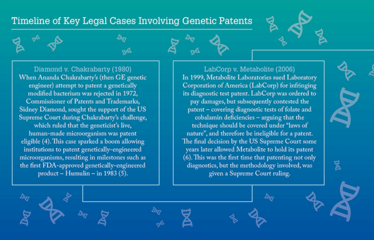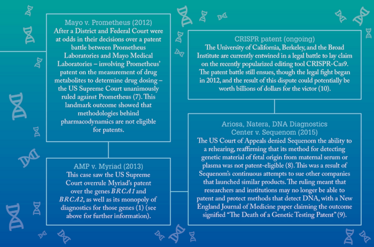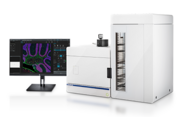The future of advanced sequencing isn’t just molded by research into new pathways and novel diagnostics and therapeutics. For those wishing to innovate in the field, it’s important to be aware of the legal battles that have been (and continue to be) fought in the courtroom around the legitimacy of certain aspects of the technique, and the precedents set by those cases. A landmark example of which is the 2013 dispute between the Association for Molecular Pathology (AMP) and Myriad Genetics (1); a legal battle that saw AMP attempt to overturn Myriad Genetics’ patents for the BRCA1 and BRCA2 genes.
Why did AMP choose to challenge the Salt Lake City-based molecular diagnostics company? It believed that allowing genes to be patented stifled clinical research and overall biomedical progress, since the patents made it impossible for others to legally detect the genes – mutations of which increase susceptibility to breast and ovarian cancer – and gave sole supplier Myriad the opportunity to keep testing costs high. In June 2013, the Supreme Court of the United States overturned Myriad’s patents and ruled that naturally-occurring DNA segments in general cannot be patented.
What this now meant was that researchers outside of Myriad could investigate and provide tests for BRCA1 and BRCA2 as well as other genes too; a boon for those hoping for a reduction in the price of testing or wanting to conduct new research in the field (2). This decision was such a milestone case in genetics, not only because of the implications for its future, but also the ripple effect that is bound to be felt by those holding pre-existing patents. Approximately 41 percent of existing genes are covered by nucleotide sequence patents in the US (3), so the ruling could jeopardize the subsequent validity of those patents if the owners decide to challenge other parties for infringing them.
The Verdict Is...
A timeline of key legal cases involving genetic patents


Read more
Genetic Panel Testing: Points of View (Steven Ralston)
Genetic Panel Testing: Points of View (Marilyn Bui)
- Supreme Court of the United States of America, “Association for Molecular Pathology et al. v. Myriad Genetics, Inc., et al.”, (2013). Available at: bit.ly/2jTCQtc. Accessed February 6, 2017.
- L Cartwright-Smith, “Patenting genes: what does Association for Molecular Pathology v. Myriad Genetics mean for genetic testing and research?”, Public Health Rep, 129, 289-292, (2014). PMID: 24790252.
- JA Rosenfeld, CE Mason, “Pervasive sequence patents cover the entire human genome”, Genome Med, 5, 27 (2013). PMID: 23522065.
- Justia, “Diamond v. Chakrabarty”, (1980). Available at: bit.ly/2kCrPyq. Accessed February 7, 2017.
- U.S Food & Drug Administration, “Celebrating a milestone: FDA’s approval of first genetically-engineered product”, (2009). Available at: bit.ly/2cGn6L3. Accessed February 8, 2017.
- Supreme Court of the United States of America, “Laboratory Corporation of America Holdings, dba LabCorp, petitioner v. Metabolite Laboratories, Inc., et al.”, (2006). Available at: bit.ly/2kjlyJg. Accessed February 6, 2017.
- Supreme Court of the United States of America, “Mayo Collaborative Services, dba Mayo Medical Laboratories, et al., v. Prometheus Laboratories, Inc.”, (2012). Available at: bit.ly/2jUs9qk. Accessed February 6, 2017.
- United States Court of Appeals for the Federal Circuit, “Ariosa diagnostics, Inc., Natera, Inc., DNA Diagnostics Center, Inc., v. Sequenom, Inc., Sequenom Center for Molecular Medicine, LLC, Isis Innovation Limited”, (2015). Available at: bit.ly/2lkhWoW. Accessed February 7, 2017.
- R Cook-Deegan, S Chandrasekharan, “Sequenom v. Ariosa – the death of a genetic testing patent”, NEJM, 375, 2418-2419, (2016). PMID: 28002697.
- Nature News, “CRISPR heavyweights battle in US patent court”, (2016). Available at: go.nature.com/2hmvZvC. Accessed February 7, 2017.
My fascination with science, gaming, and writing led to my studying biology at university, while simultaneously working as an online games journalist. After university, I travelled across Europe, working on a novel and developing a game, before finding my way to Texere. As Associate Editor, I’m evolving my loves of science and writing, while continuing to pursue my passion for gaming and creative writing in a personal capacity.




















